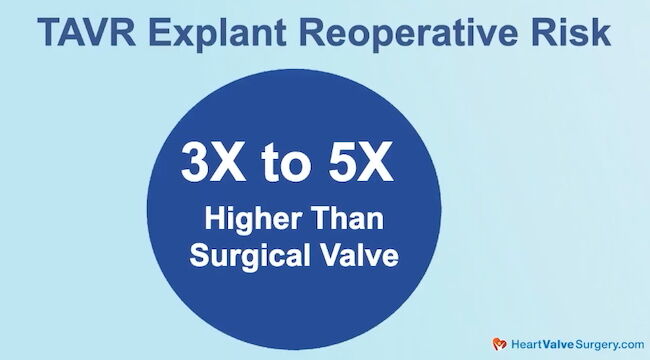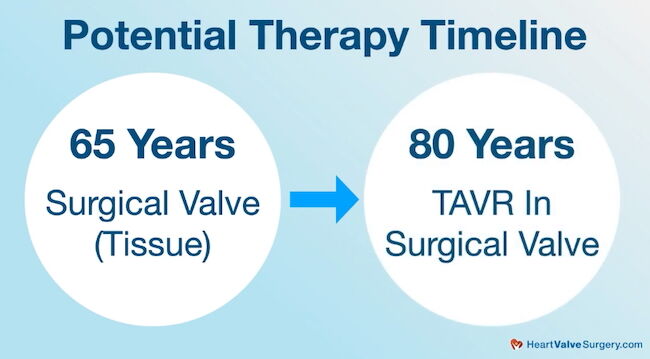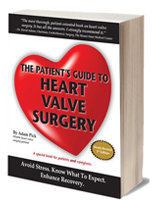TAVR Explants & The Lifetime Management of Aortic Stenosis
Written By: Allison DeMajistre, BSN, RN, CCRN
Medical Expert: Pedro Catarino, MD, Director of Aortic Surgery, Cedars-Sinai, Los Angeles, California
Reviewed By: Adam Pick, Patient Advocate, Author & Website Founder
Published: October 14, 2025
In 2020, the statistics showed that more transcatheter aortic valve replacement (TAVR) were performed than any other form of surgical aortic valve replacement (SAVR), with over 276,000 patients having undergone a TAVR in the United States. The benefits of TAVR include a shorter length of stay and fewer post-operative complications like bleeding and other cardiac complications associated with SAVR, so many patients find the procedure a much more attractive option.
However, both the American College of Cardiology and the American Heart Association recommend SAVR over TAVR in patients under 65 with severe aortic stenosis. That’s because bioprosthetic heart valves eventually fail, and reintervention with a surgical explant of the old valve and replacement with another will be necessary. In addition, new research in the Journal of Thoracic and Cardiovascular Surgery suggest that TAVR explant procedures are currently the fastest-growing cardiac surgery procedure in the United States.
We recently received excellent patient questions about TAVR explants from Kevin, who asked, “I’m 65 years old, active, and in the ‘waiting room’ for aortic stenosis. What is the latest information about TAVR explants? How should I think about TAVR explants when planning the lifetime management of my aortic valve disease?” I met with Dr. Pedro Catarino, the Director of Aortic Surgery at Cedars-Sinai in Los Angeles, to answer Kevin’s question.
Key Learnings About TAVR Explants
Here are important insights shared by Dr. Catarino:
- What are the options for a TAVR explant? “That’s a tough question, so I’m going to give you a slightly complicated answer,” said Dr. Catarino. “If you’re thinking about a TAVR explant, that means you’ve already got a TAVR. If the TAVR fails, your best option is another TAVR inside the first TAVR. Sometimes, that’s not feasible for technical reasons, and then you need open surgery to do the TAVR explant. Having a TAVR in place greatly complicates the surgery because the TAVR has become impregnated in the aortic wall, and removing it is quite tricky.

- What are the risks of repeat surgery and the surgical options? Dr. Catarino said, “The risks of repeat surgery where there’s a TAVR in place are three to five times higher than the risks of repeat surgery when there is a previous surgical valve. If I come back to Kevin, who is potentially waiting for a TAVR or some intervention for his aortic stenosis. I would say at 65 years old, he should probably be looking to have a low-risk surgical aortic valve replacement with a tissue valve, which would see him through 15 years, at which point Kevin would be 80. He could then have a TAVR inside the surgical aortic valve, which is a straightforward procedure. That will see him through to 100 years.

- Do you plan the lifetime management of valve disease with the patients in your office like you just did with Kevin? “Yes, absolutely,” said Dr. Catarino. “Every patient needs to think about the lifetime management of their condition and how the decision they make now will impact their life in 10, 15, or 20 years.” Dr. Catarino explained that doctors often offer TAVR over SAVR, which many patients want to choose because it’s the easy, immediate option. “That may deal with the situation now, but it may complicate things further down the line. So, I say to patients, you must think about your whole lifetime in whatever procedure you choose.”
Thanks Dr. Catarino and Cedars-Sinai!
On behalf of Kevin, the HeartValveSurgery.com community, and patients all over the world, thank you, Dr. Pedro Catarino, for sharing your experience and insight into TAVR explants and the lifetime management of aortic stenosis. A big thanks to the entire team at Cedars-Sinai Medical Center for taking great care of all our heart valve patients!
Related links:
- Surgeon Q&A: SAVR and TAVR Insights
- Hannah’s TAVR Explant Story: From Palliative Care to Life-Saving Miracle
Keep on tickin,
Adam
P.S. For the deaf and hard-of-hearing members of our patient community, we have provided a written transcript of our interview with Dr. Catarino below.
Video Transcript:
Adam Pick: Hi, everybody. It’s Adam with HeartValveSurgery. com, and we’re at Cedars-Sinai Medical Center in Los Angeles, California. I am thrilled to be joined by Dr. Pedro Catarino, who is the Director of Aortic Surgery.
Dr. Catarino, it is great to see you. And thanks so much for being with me today. My pleasure. Thank you for having me, Adam. We’re here at Cedars-Sinai and we have this great opportunity with you to answer some patient questions. And this one came in from Kevin who asks, “I’m 65 years old, active, and in the waiting room for aortic stenosis. What is the latest information about TAVR explants? How should I think about TAVR explants when planning the lifetime management of my aortic valve disease?”
Dr. Pedro Catarino: Tough question. So, I’m going to give you a slightly complicated answer. If you’re thinking about TAVR explant, that means you’ve already got a TAVR.
Really your best option, if the TAVR is failing, is another TAVR. So, inside that first TAVR. Sometimes, that’s not feasible for technical reasons. Then you need open surgery to do the TAVR explant, which I think is Kevin’s question. And having a TAVR in place greatly complicates the surgery because the TAVR has become sort of impregnated in the aortic wall and removing the TAVR is quite tricky.
The risks of repeat surgery where there’s a TAVR in place are higher than the risks of repeat surgery just when there’s a previous surgical valve, maybe three to five times higher. If I come back to Kevin, who’s waiting for potentially a TAVR or some intervention on his aortic stenosis, I would say at 65 years old, I’d probably be looking to have a low risk surgical aortic valve replacement with a tissue valve, which would see you through 15 years, so Kevin would be 80.
And then, at that point, have a TAVR inside the surgical aortic valve. Quite a straightforward procedure. And then that sees him through to 100 plus.
Adam Pick: I’ve got to ask you, Dr. Catarino, the way that you just plan this out for Kevin and the lifetime management of his valve disease, is this what you do with most of your patients who come into your office?
Dr. Pedro Catarino: Yes, absolutely. Every patient needs to think about their lifetime management of their condition and what the implications are for a decision now on their life in 10, 15, 20 years time. And I think sometimes, one wants to take the easy, immediate option, which the doctor may offer you, which maybe transcatheter, not surgery.
And that may deal with the situation now, but it may complicate things further down the line. So, I say to patients, you must think about, your whole lifetime in whatever procedure you choose.
Adam Pick: Well, Kevin, I hope that helped you. I know it helped me and Dr. Catarino on behalf of all the patients at HeartValveSurgery.com, patients all over the world watching this, thank you for everything you and your team are doing here at Cedars Sinai. Thanks for being with me today.
Dr. Pedro Catarino: Thank you. Adam. It was a pleasure being with you.




